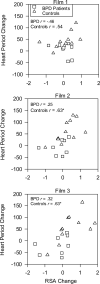Borderline personality disorder and emotion regulation: insights from the Polyvagal Theory
- PMID: 17659821
- PMCID: PMC2082054
- DOI: 10.1016/j.bandc.2006.05.007
Borderline personality disorder and emotion regulation: insights from the Polyvagal Theory
Abstract
The current study provides the first published evidence that the parasympathetic component of the autonomic nervous system differentiates the response profiles between individuals diagnosed with borderline personality disorder (BPD) and controls. Respiratory sinus arrhythmia (RSA), a non-invasive marker of the influence of the myelinated vagal fibers on the heart, and heart period were collected during the presentation of film clips of varying emotional content. The BPD and control groups had similar initial levels of RSA and heart period. However, during the experiment the groups exhibited contrasting trajectories, with the BPD group decreasing RSA and heart period and the control group increasing RSA and heart period. By the end of the experiment, the groups differ significantly on both RSA and heart period. The correlation between the changes in RSA and heart period was significant only for the control group, suggesting that vagal mechanisms mediated the heart period responses only in the control group. The findings were consistent with the Polyvagal Theory [Porges, S. W. (1995). Orienting in a defensive world: Mammalian modifications of our evolutionary heritage: A Polyvagal Theory. Psychophysiology, 32, 301-318; Porges, S. W. (2001). The Polyvagal Theory: Phylogenetic substrates of a social nervous system. International Journal of Psychophysiology, 42, 123-146; Porges, S. W. (2003). Social engagement and attachment: A phylogenetic perspective. Annals of the New York Academy of Sciences, 1008, 31-47.], illustrating different adaptive shifts in autonomic state throughout the course of the experiment. The BPD group ended in a physiological state that supports the mobilization behaviors of fight and flight, while the control group ended in a physiological state that supports social engagement behaviors. These finding are consistent with other published studies demonstrating atypical vagal regulation of the heart with other psychiatric disorders.
Figures
References
-
- American Psychiatric Association. Diagnostic and statistical manual of mental disorders. 4th ed. Author; Washington, D.C.: 1994.
-
- American Psychiatric Association. Diagnostic and statistical manual of mental disorders. 4th ed., text revision Author; Washington, D.C.: 2000.
-
- Anderson AK, Phelps EA. Expression without recognition: Contributions of the human amygdala to emotional communication. Psychological Science. 2000;11:106–111. - PubMed
-
- Bagge C, Nickell A, Stepp S, Durrett C, Jackson K, Trull TJ. Borderline personality disorder features predict negative outcomes 2 years later. Journal of Abnormal Psychology. 2004;113:279–288. - PubMed
-
- Benjamin LS. Interpersonal diagnosis and treatment of personality disorders. 2nd ed. Guilford Press; New York: 1996.
Publication types
MeSH terms
Grants and funding
LinkOut - more resources
Full Text Sources
Medical



